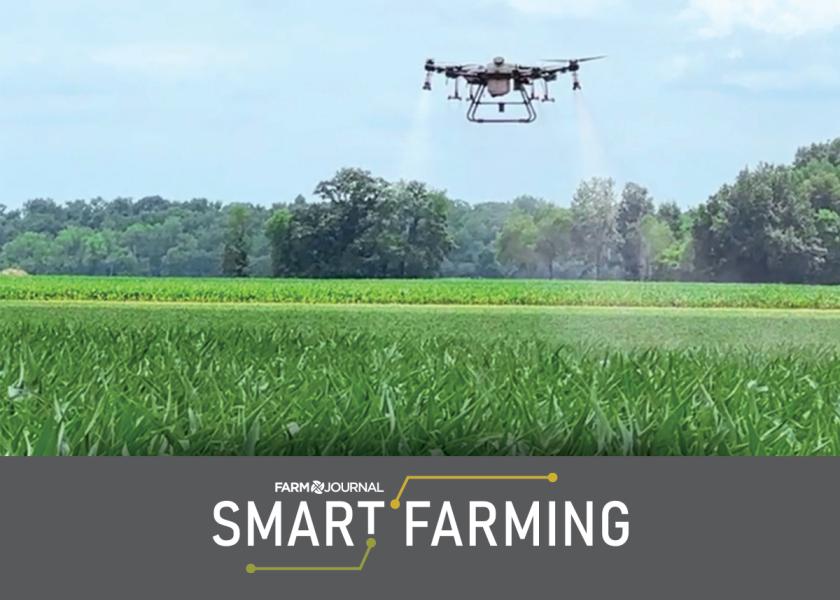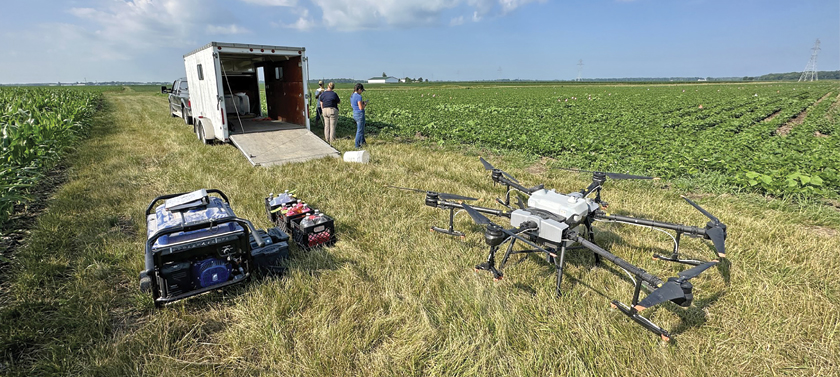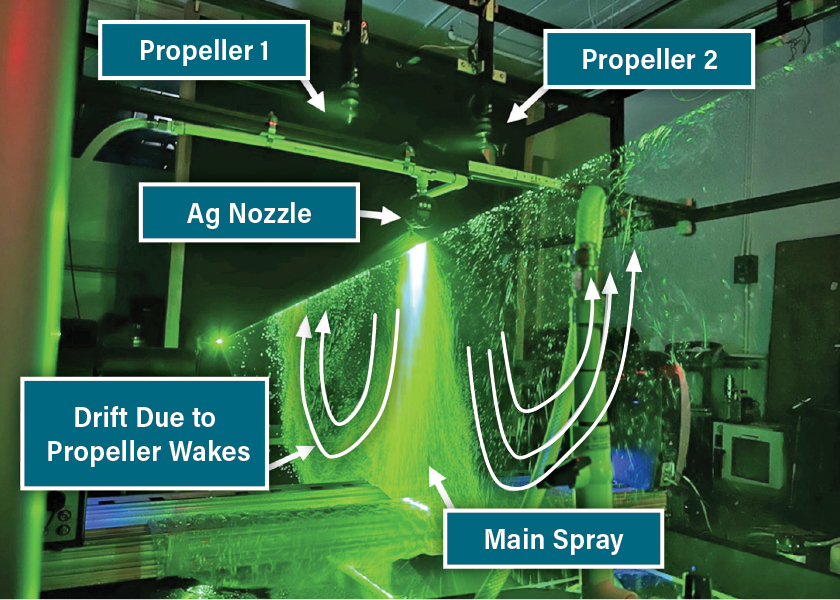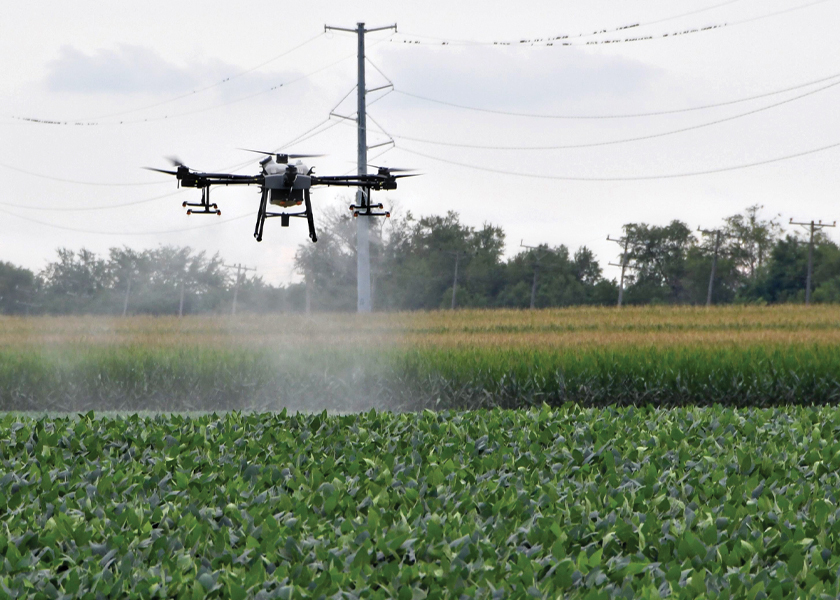Rise of the Spray Drone

Squinting through the morning sun, Jesse Patrick watches the top of his corn crop whip in the downdraft of a large spray drone pipping fungicides into the canopy.
“The drone is only putting out 2 gal. an acre, but the thing that surprised me was the swath and amount of downdraft coming off of it even flying 15' above the corn,” Patrick recalls.
This seventh-generation farmer, who grows soybeans, corn, wheat, hay and sorghum, and also serves on the United Soybean Board, is used to battling weeds and disease in his heavy Georgia clay soils about an hour east of Atlanta. Treating those yield robbers with a drone, however, is new.
“When the drone lands, you pull the battery out, fill it up, put in a new battery and the whole thing takes about 15 seconds,” Patrick says. “It’s a pretty well-oiled machine.”

Drone-driven sprayers are popping up across the country as better batteries, longer flight times and bigger machines make it possible to spray sizable acreage in a timely manner.
“There’s a 10-gal. tank so every 5 acres he has to come back to refill,” Patrick explains. “We knocked out 150 acres in about four to six hours.”
Does it Work?
While farmers such as Patrick find the technology useful, especially for spot spraying and targeting fields in less-than-ideal conditions, weed scientists are buzzing with more caution.
“We [weed scientists] are very sensitive about the resistance issue we have in weeds to herbicides, and as I've heard about using drones for applications, I wonder who’s testing it,” says Bryan Young, a weed scientist at Purdue University. “I wondered if we are going to generate more resistance, if this is a sub-optimal application, and I wasn’t getting a lot of answers.”
That kick-started a research project into drone sprayers and verifying the new application method is effective enough to do the job. Young has witnessed the potential benefits of sprayer drones; however, as with all new technology, he’s still quantifying and investigating the results.

“I was looking around for any guidelines on the best spray drone design in terms of nozzles and boom configuration,” Young says. “Frankly, to date, I can’t tell you where the industry is headed for sure or what is the best setup for herbicide application. This is an emerging technology for commercial applications in the U.S.”
Drone operators often tout the strong down draft helping push product into the canopy, but then fly at higher elevations to maximize field coverage or spray swath. Young says these application methods are significantly different than traditional aerial applications, and it’s why he’s part of a working group looking into whether product labels should include separate drone application guidelines.
“Right now, the U.S. EPA has left it up to each state to determine whether drones can be used for herbicide applications following the aerial component of the herbicide labels,” Young explains. “Not all states agree on that and not all countries agree.”
Then there’s the question of drift. It’s still being investigated exactly how much different spraying with a drone is versus a ground-based sprayer or even by airplane.
Wind Tunnel Testing
“Underneath the drone’s propellers what would normally be a flat fan spraying from the nozzle, all of a sudden, [the pattern] starts to bend and oscillate,” explains Kyle Butz, a technical adviser with Spray Analytics.
He’s been working with Sidaard Gunasekaran, a professor of mechanical and aerospace engineering at the University of Dayton, to test the effects of drone propellers on pesticide and herbicide application during flight. The two recently released their findings on droplet drift using the university’s low-speed wind tunnel.

“I think Kyle and I both asked the same question: On what basis are they deciding where to put the nozzles?” Gunasekaran recounts. “It turns out, they just take an agriculture nozzle, stick it underneath the propeller and then go fly without understanding the aerodynamics or the right location for that nozzle.”
In search of answers, Gunasekaran and Butz developed a test rig with two propellers, a spray nozzle and a measurement system. They confirmed the propellers do in fact pull droplets back into the down draft while blowing smaller droplets out away from the target zone.
“If you have smaller droplets, called fines, which are anything under 140 microns, they are prone to drift,” Gunasekaran says.
From a sprayer’s perspective, however, there’s always been a balancing act between droplet sizes and efficacy.
“Ultimately, spray applications come down to, one, droplets have to be large enough to safely reach the target, and two, they have to be small enough to work the way they’re supposed to be working,” Butz explains.
Their recommendation is to start with products less likely to drift and use a drone in scenarios or situations that are less sensitive.

A Tool Worth Trying
Like with all new technology, drone sprayers will no doubt have to earn their stripes. For farmers such as Patrick, it’s just another tool to deploy when the situation is right, such as when the aphids are going crazy on his sorghum but it just rained 2" and he can’t run a sprayer.
Today, he does not see this technology replacing the pre- or post-emerge passes on his operation.
“However, at the end of the year, if you don’t want to run over a bunch of crops to spot spray, I think drone sprayers are definitely a tool we can use,” he says.
“There’s a definite fit for these drones,” Young agrees. “It can allow us to be more timely with some of our pesticide applications and for us to be better stewards of pesticides.”







